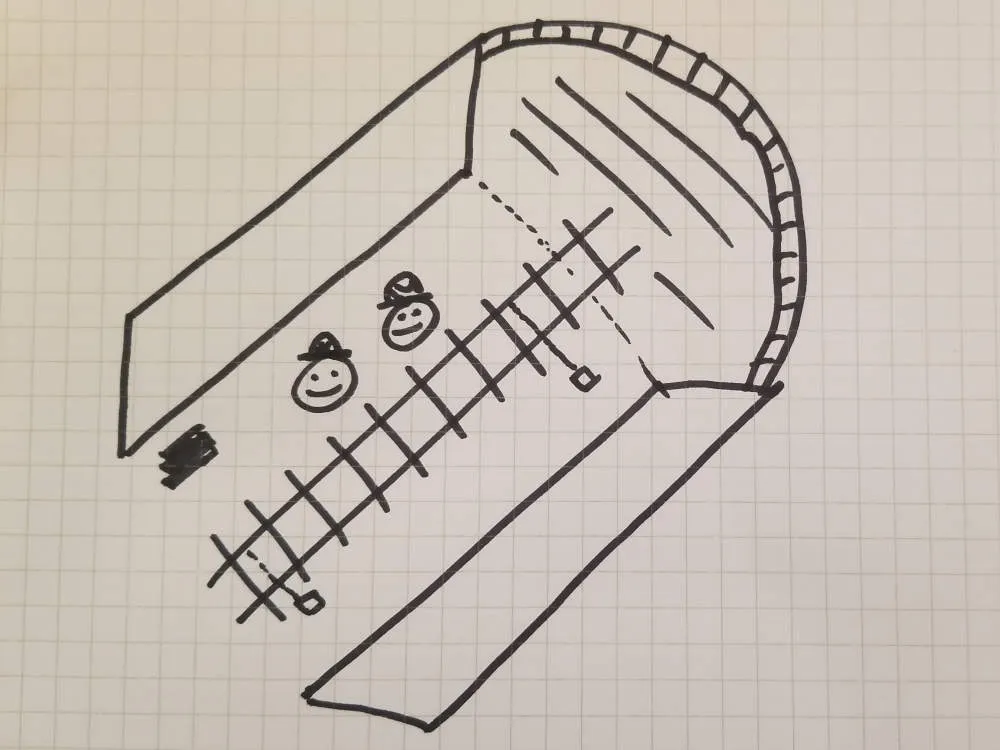Why trains honk and what can be done to reduce the noise
Written by Chris, updated Jun 18 2019 in accordance with our editorial policy.
Trains honk their horns in warning every time there is added possibility that the train may injure a person. Trains typically honk their horns at level crossings, pedestrian crossings, when leaving a station, when running express through a station, when they start moving in a depot, when they’re going past a maintenance crew, and when they see a person or animal on the tracks. That’s a lot of noise that trains can make, but people are still surprised when I tell them how quiet trains can be.
 A train approaching, ready to honk its horn in warning. Source
A train approaching, ready to honk its horn in warning. Source
I used to work on the tracks. Trains came by approximately every 15 minutes, but you never knew exactly. We needed to get to a place of safety when they did. The only warning was a shout and a whistle from a person whose job it was to look out for trains. Trains are quiet. When you’re in front of a train, the only warning noise it naturally makes is a soft squeal in the rail.
Once the train driver saw us working nearby, the driver would give us a quick honk to let us know he’d seen us. If anyone where in his way, he’d give a long and loud honk in warning to get us off the track.
When people are crossing the tracks, either by car or on foot
Trains are quiet when they’re bearing down on you. People using a crossing, whether by car or on foot, may not realise the train is coming. There are warning bells, but if you’re on your phone or have the radio on, you might not notice them. The train honks its horn just in case.
The train will likely give a couple of honks: One when it’s approaching the crossing, but you can’t see it yet, and one when it’s on the crossing. It’s to warn people that the train is coming, and to stay out of the way.
 Australia sees a handful of collisions between cars and trains each year
Australia sees a handful of collisions between cars and trains each year
While on average there are only a handful of level crossing accidents per year, reports into these accidents often detailed the people who died as a result. This data was analysed for Australia, where there is an extensive network of rail infrastructure. Similar results could be expected scaled appropriately for the US and Canada.
It cannot be counted, but the honk of a train horn may have saved many more people from ending up on the tracks as a train was coming through.
Prevent people falling off the platform at stations
People run to catch the train. They jump through at the last minute, or they force the closing doors to open again so they can get on. A warning from the driver that the train is about to leave lets these people know they’ve run out of time. If you run for a train and don’t make it, you might fall in to the gap between the train and the platform. When the trains departs, it will run over you.
When a train isn’t stopping at this station, it will honk the horn to warn anyone on the platform that a fast train is coming through. Sometimes trains run express through a station, or a freight train might run through that couldn’t even stop if it wanted. The passenger information might give you an announcement, but a train driver will honk his horn regardless. Better the noise and be alert than to fall onto the tracks when surprised by the sudden passing train.
On a good train system, the next train is only a few minutes away. Wait for the next train instead of running for this one.
To warn work crews
Train depots have a lot of background noise. Engines idling, amplified by the echo from parked trains. Workers moving around the depot won’t hear a train that takes off. Especially if it’s in reverse. Drivers honk the horn of the train just before it starts moving to warn those in the vicinity there is a moving train, and to keep an eye out.
Depots are a dangerous place. A warning honk can make it that little bit safer for people who work there.
Intruder on the tracks
Train drivers don’t want to strike anything, especially a wild animal or a person. If something is on the tracks and a honk of a horn might move it off, you can bet the train driver will honk the horn!
The first time I drove a train there was a cow on the tracks. All the honking in the world refused to move it. We had to stop the train and wait. Luckily we were driving slow enough to stop the train before we hit the cow. Things don’t end well for trains or animals when they’re stuck on a track.
 Trains honk at people in the rail corridor
Trains honk at people in the rail corridor
What can be done to reduce train noise?
Remove road and pedestrian crossings. Trains have to honk at a road or pedestrian crossing, even ones with lights. If these are removed, usually building a bridge or an underpass, the train doesn’t need to honk anymore.
Noise barriers can be built around stations or along the line to contain the noise in the rail corridor. The first rail line I worked on added noise walls to an existing rail corridor. They help reduce a lot of the noise of trains, a honk still comes through but it’s much softer. Noise barriers can also present a challenge for maintenance workers who have further to walk to get to equipment; in a fault this could be more minutes of delay.
Rail corridor is a term that we use to describe the part of land allocated to the rail line. I wrote a better explanation of this and other rail terms that can be found here: https://econstructioncareers.com/news-insight/rail-concepts-for-starters
Fences to prevent intruders. If trains near you are honking because of intruders on the track - especially animals - a good fence might. Fencing off the rail corridor to prevent animals getting in means those animals won’t get in the path of the train.
Put the line in a tunnel. This is a tough sell for politicians, by it can help in some cities. If the train’s in a tunnel, it’s very hard to hear any honks.
All these options require the rail operator, land owner, or government to invest money. The challenge is convincing them it’s worth it.
Trains honk their horns for safety. The noise they make serves as a warning to others: The train is about to move, you won’t hear it coming otherwise, so get out of the way.
Have you ever considered a job working with trains? Working with trains is a future-proof career, click here to find out more about how you can join in: https://econstructioncareers.com/news-insight/rail-engineer-good-career
Related articles:
- 5 Concepts to Learn When Starting a Career in Rail: https://econstructioncareers.com/news-insight/rail-concepts-for-starters
- How trains avoid collision: https://econstructioncareers.com/news-insight/how-trains-avoid-collision